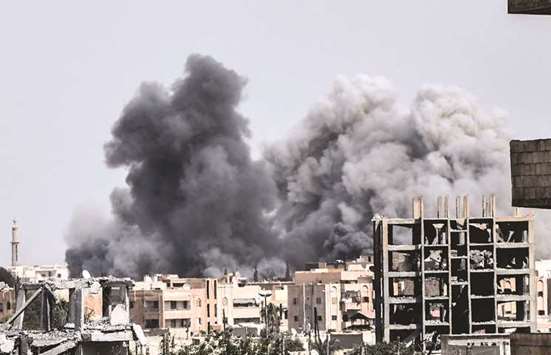Heavy bombardment and fierce fighting shook the Islamic State group’s Syrian stronghold Raqqa yesterday, as US-backed forces said they captured a new neighbourhood from entrenched militants.
Bursts of gunfire and artillery as well as the thud of air strikes conducted by the US-led coalition filled the air in western neighbourhoods of Raqqa, on what AFP’s correspondent said was the heaviest day of bombardment to date.
Thick pillars of black smoke dotted the city skyline, lined with bombed-out concrete homes and the damaged minaret of a mosque.
“Our American friends are bombing with mortars,” a fighter from the Syrian Democratic Forces (SDF) said after a string of blasts near the front line in western Raqqa.
The SDF’s Kurdish and Arab fighters have been pressing an operation to capture the militant stronghold since last year with coalition air support and the backing of a US Marines artillery battery.
An AFP reporter in Jazra suburb on the western outskirts of the city yesterday saw coalition forces at a joint position with SDF fighters firing artillery in the direction of IS posts deeper inside Raqqa.
The SDF has spent several months encircling Raqqa and first broke into the northern city in early June.
Yesterday, it announced it had captured Al-Yarmuk, a large neighbourhood on the southwestern outskirts of the city.
“The Al-Yarmuk district was liberated yesterday,” the SDF’s spokeswoman for the Raqqa operation, Jihan Sheikh Ahmed, said in Ain Issa,
50 kilometres north of Raqqa.
“We are taking steady and sound steps. What is important to us is not speed, but liberating civilians and eliminating Daesh (IS),” she added.
IS first seized Raqqa in early 2014, and the city has since become synonymous with the group’s most gruesome atrocities.
It carried out brutal public beheadings and is thought to have used Raqqa as a hub for planning attacks overseas.
The militants are putting up a fierce defence against the SDF, including with car bombs, improved explosive devices, and weaponised commercial drones.
SDF fighters yesterday heard a light buzzing noise coming from outside and began looking to the sky.
“It’s a Daesh drone,” one militiaman warned. Progress inside Raqqa has also been hampered by extensive mining of neighbourhoods, with devastating consequences for civilians trying to flee.
“There have been many casualties, fighters and civilians, caused by mines,” an SDF commander said, without giving his name.
“Yesterday, we buried six civilians after a mine exploded as they were trying to escape.”
The United Nations estimates that up to 50,000 civilians remain trapped in Raqqa, down from some 100,000 people at the end of June.
The SDF on its social media accounts said yesterday its forces “managed to free about 500 civilians who were trapped inside the Al-Daraiya and Al-Tayar neighbourhoods, as well as 150 others from the Old City” in Raqqa.
The Syrian Observatory for Human Rights said hundreds of civilians had fled IS-held parts of the city in the past 48 hours towards areas now controlled by the SDF.

Heavy smoke billows following an air strike on the western frontline of Raqqa yesterday, during an offensive by the US-backed Syrian Democratic Forces.
